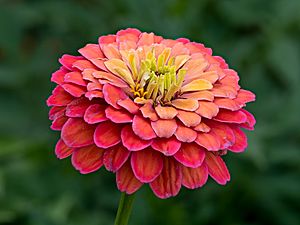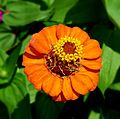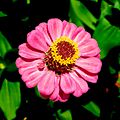Zinnia elegans facts for kids
Quick facts for kids Zinnia elegans |
|
|---|---|
 |
|
| Scientific classification | |
| Genus: |
Zinnia
|
| Species: |
elegans
|
| Synonyms | |
|
|
The Common Zinnia (Zinnia elegans), also called youth-and-age or elegant zinnia, is a beautiful flowering plant. It is an annual, which means it grows, flowers, and dies within one year. This plant belongs to the Asteraceae family, which includes daisies and sunflowers.
Common Zinnias originally come from Mexico. Today, people grow them as ornamental plants in many places around the world. You can find them growing wild in parts of South and Central America, the United States, Australia, and Italy.
Contents
What Does a Zinnia Look Like?
Wild Zinnia plants usually grow to be about 13 centimeters (5 inches) tall. Each plant has single flower heads that are about 5 centimeters (2 inches) wide. The flowers have purple petals, called ray florets, around a center of black and yellow parts.
The leaves of the Zinnia are shaped like a spear, which is called lanceolate. They grow opposite each other on the stem. Zinnias typically bloom, or flower, during the warm summer months.
How Zinnias Got Their Name
The Zinnia plant was first found in Mexico in 1789. It was later given the name Zinnia violacea in 1791. Another scientist, Nikolaus Joseph von Jacquin, described it again in 1792 as Zinnia elegans. This is the name we use today.
The whole group of Zinnia plants, called the genus Zinnia, was named after a German botanist. His name was Johann Gottfried Zinn. He studied a similar plant in 1757.
Growing Zinnias in Your Garden
Garden Zinnias are very popular plants. They were created by mixing different types of wild Zinnias. There are hundreds of different kinds, called cultivars, with many flower colors, sizes, and shapes. Some giant Zinnias can have flowers up to 15 centimeters (6 inches) across!
Zinnia flowers come in almost every color. You can find them in white, cream, pink, red, purple, green, yellow, orange, and even bronze. Some flowers have stripes or speckles. There are also "pom-pom" Zinnias that look like small dahlias.
Zinnias can be very small, less than 15 centimeters (6 inches) tall. Others can grow as tall as 90 centimeters (3 feet). Newer types of Zinnias are also better at resisting a common plant disease called powdery mildew.
Many Zinnia types have won awards for being great garden plants. Some popular ones include 'Benary's Giant Salmon Rose', 'Dreamland Mixed', and 'Purple Prince'. Other well-known types are 'Magellan', 'Profusion Cherry', and 'Crystal White'. You can often buy seeds that grow a mix of different colors.
Best Conditions for Zinnia Growth
Zinnias are easy to grow. They like soil that drains water well and gets lots of sunshine. They grow best in places that are dry, warm, and do not have frost. Many types can even handle dry weather.
Because Zinnias do not like cold temperatures, you should plant them after the danger of frost has passed. If you live in a colder area, you can start the seeds indoors. Then, carefully move the young plants outside once the weather gets warmer.
Gallery
See also
 In Spanish: La rosa mística para niños
In Spanish: La rosa mística para niños










